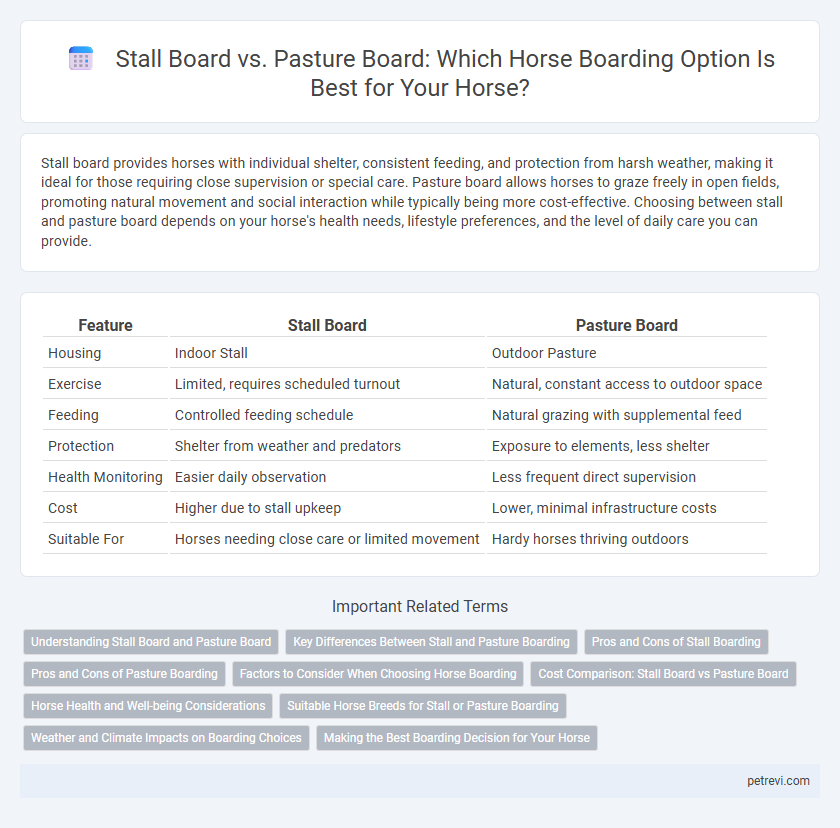Stall board provides horses with individual shelter, consistent feeding, and protection from harsh weather, making it ideal for those requiring close supervision or special care. Pasture board allows horses to graze freely in open fields, promoting natural movement and social interaction while typically being more cost-effective. Choosing between stall and pasture board depends on your horse's health needs, lifestyle preferences, and the level of daily care you can provide.
Table of Comparison
| Feature | Stall Board | Pasture Board |
|---|---|---|
| Housing | Indoor Stall | Outdoor Pasture |
| Exercise | Limited, requires scheduled turnout | Natural, constant access to outdoor space |
| Feeding | Controlled feeding schedule | Natural grazing with supplemental feed |
| Protection | Shelter from weather and predators | Exposure to elements, less shelter |
| Health Monitoring | Easier daily observation | Less frequent direct supervision |
| Cost | Higher due to stall upkeep | Lower, minimal infrastructure costs |
| Suitable For | Horses needing close care or limited movement | Hardy horses thriving outdoors |
Understanding Stall Board and Pasture Board
Stall board provides horses with individual indoor stalls, offering protection from harsh weather and controlled feeding schedules, which helps maintain their health and performance. Pasture board allows horses to live outdoors in a natural environment with open space for grazing and exercise, promoting mental well-being and natural social behaviors. Choosing between stall board and pasture board depends on factors like climate, horse temperament, and owner preferences for management and care.
Key Differences Between Stall and Pasture Boarding
Stall board provides individual shelter, controlled feeding, and protection from weather, which is crucial for horses with special dietary or health needs. Pasture board offers extensive outdoor grazing and exercise but may expose horses to varying weather conditions and limited supervision. Choosing between stall and pasture boarding depends on a horse's temperament, health requirements, and the owner's management preferences.
Pros and Cons of Stall Boarding
Stall boarding offers horses protection from harsh weather and reduces the risk of injury from rough terrain while allowing for controlled feeding and monitoring of health. However, it can lead to limited exercise and social interaction, potentially causing behavioral issues or decreased physical fitness. Maintenance costs and labor for cleaning stalls daily also contribute to higher overall expenses compared to pasture boarding.
Pros and Cons of Pasture Boarding
Pasture boarding offers horses extensive outdoor access, promoting natural grazing behavior and enhanced mental well-being through increased social interaction and exercise. However, it may expose horses to weather extremes, parasites, and variable forage quality, requiring diligent management practices. This option is cost-effective compared to stall board but demands consistent monitoring to prevent injuries and nutritional deficiencies.
Factors to Consider When Choosing Horse Boarding
Choosing between stall board and pasture board for horse boarding depends on factors such as the horse's health needs, climate considerations, and the owner's budget. Stall board offers protection from harsh weather and closer supervision, ideal for horses requiring regular medical care or intensive training. Pasture board suits horses that thrive on natural grazing and social interaction, often resulting in lower costs but requiring suitable fencing and pasture management.
Cost Comparison: Stall Board vs Pasture Board
Stall board typically incurs higher costs due to daily feeding, stall cleaning, and bedding expenses, averaging between $300 to $800 per month depending on location and services. Pasture board offers a more affordable option, often ranging from $150 to $400 monthly, as it reduces labor and material costs by allowing horses to graze freely with minimal shelter needs. Evaluating these expenses alongside individual horse care requirements is essential for selecting the most cost-effective boarding solution.
Horse Health and Well-being Considerations
Stall board provides horses with shelter, controlled feeding, and protection from harsh weather, reducing stress and risk of injury, which supports consistent health management. Pasture board promotes natural movement, social interaction, and mental stimulation, enhancing cardiovascular fitness and reducing behavioral issues. Evaluating individual horse needs and environmental factors is essential to optimize health and well-being in boarding choices.
Suitable Horse Breeds for Stall or Pasture Boarding
Thoroughbreds and Warmbloods, known for their high energy and training demands, are often better suited to stall board environments that provide controlled exercise and protection. Conversely, hardy breeds like Quarter Horses and Mustangs thrive in pasture boarding due to their natural resilience and ability to graze freely for extended periods. Selecting the appropriate board type depends on the horse's breed-specific temperament, exercise needs, and health considerations.
Weather and Climate Impacts on Boarding Choices
Stall board offers horses protection from extreme weather conditions such as intense heat, heavy rain, or freezing temperatures, ensuring consistent care regardless of climate fluctuations. Pasture board allows horses to graze freely and benefit from natural sunlight and ventilation, but can expose them to adverse weather, requiring horses with delicate health to have access to shelter. Climate regions with harsh winters or hot summers often influence owners to prefer stall board for controlled environments, while moderate climates may support pasture boarding for overall horse well-being.
Making the Best Boarding Decision for Your Horse
Stall board offers horses a controlled environment with consistent feeding, protection from harsh weather, and individual attention essential for horses with specific health or training needs. Pasture board promotes natural grazing, social interaction, and exercise, benefiting horses with strong stamina and sound hooves accustomed to outdoor living. Evaluating your horse's health, temperament, and lifestyle requirements is critical to making the best boarding decision that supports their well-being and performance.
Stall Board vs Pasture Board for Horse Boarding Infographic

 petrevi.com
petrevi.com